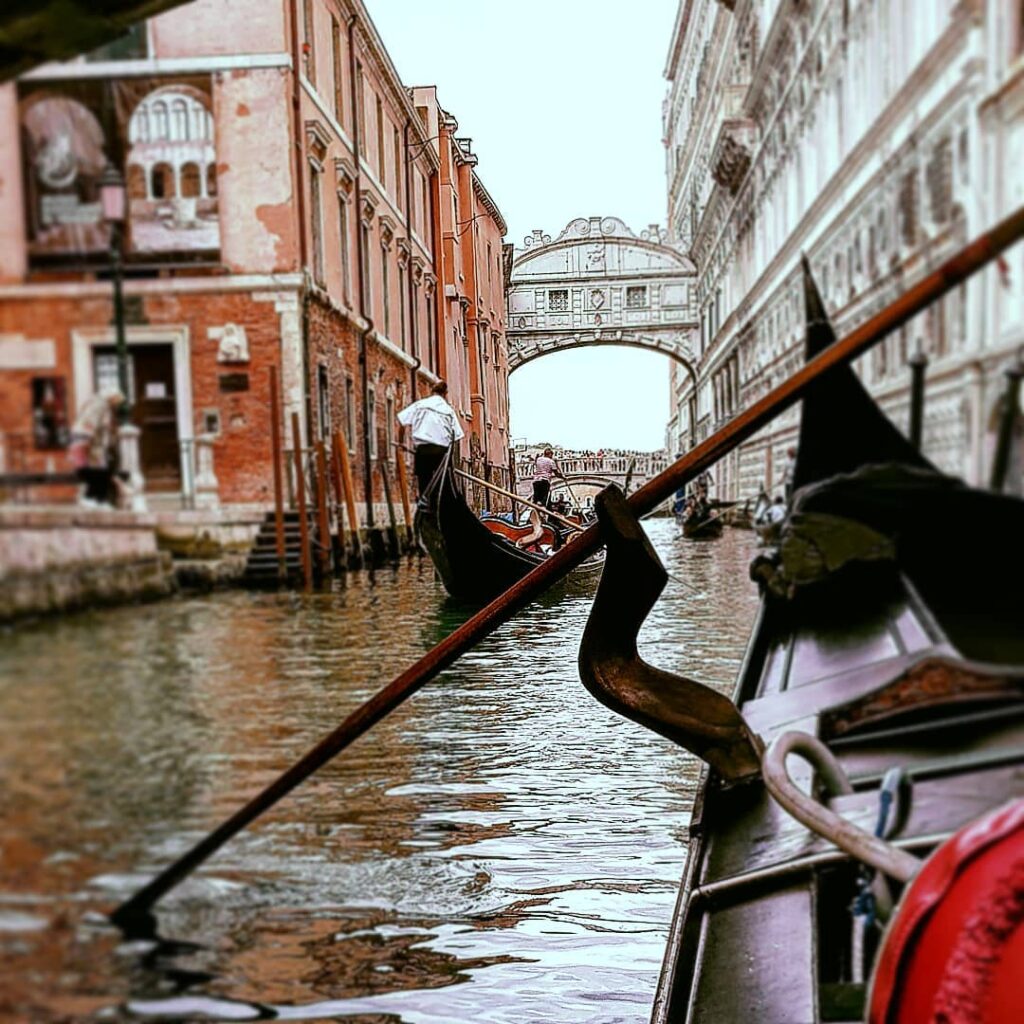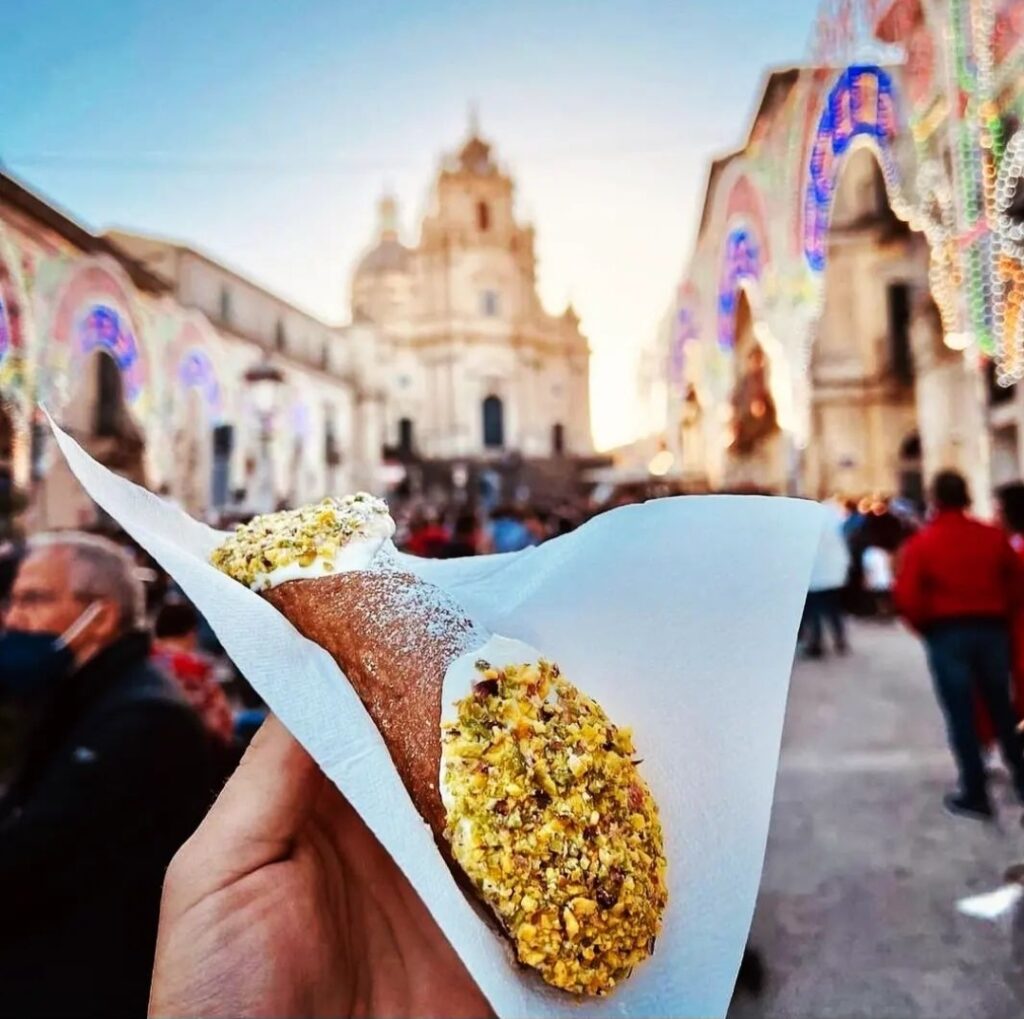Rome by night tour with a private limo and guide, including these iconic sites:
Rome by night is a captivating journey through the heart of the Eternal City. As the sun sets and the city’s historic landmarks light up, you’ll experience the magic of Rome in a new and enchanting way. From the iconic Piazza Venezia, where history comes to life at the Altare della Patria, to the awe-inspiring Pantheon, and the breathtaking views from Gianicolo Hill, every moment is a testament to the city’s timeless beauty. Stroll through Piazza Navona, where Bernini’s fountains come alive in the evening glow, and make a wish at the Fontana di Trevi. With a private limo and guide, this night tour is a journey through history and enchantment, where the past and present meet under the Roman moonlight.
Piazza Venezia: Piazza Venezia is your starting point, dominated by the Altare della Patria, a grand monument dedicated to Italy’s first king. The square’s central location makes it the heart of Rome and an excellent starting point for your journey.
Piazza Venezia stands as a symbol of Italy’s unification and serves as a central point for exploring the heart of Rome. Its grand architecture and historical significance make it a must-visit location in the Eternal City.
GET IN TOUCH
Schedule a Visit
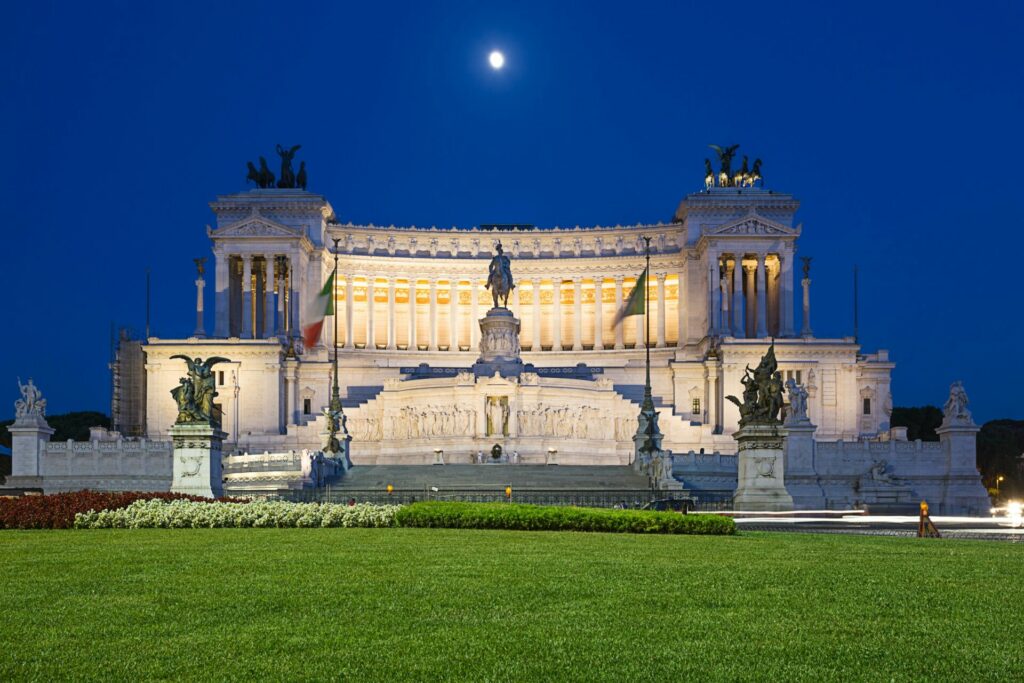
Here are some interesting facts about Piazza Venezia:
- Monument to Vittorio Emanuele II: Piazza Venezia is home to the monumental Altare della Patria (Altar of the Fatherland), also known as the Victor Emmanuel II National Monument. This massive white marble structure was built in honor of Italy’s first king, Victor Emmanuel II, who played a pivotal role in the country’s unification in the 19th century.
- Central Location: Piazza Venezia is a central hub of Rome and serves as a major traffic junction, with several important roads converging at this square. It is often considered the starting point for exploring Rome, and many of the city’s main streets radiate from this location.
- Imposing Architecture: The Altare della Patria, designed by Giuseppe Sacconi, is known for its grand and imposing architecture. The monument features a combination of classical and neoclassical elements, including Corinthian columns, statues, and sculptural reliefs.
- Equestrian Statue of Victor Emmanuel II: At the center of the monument, you’ll find an enormous equestrian statue of King Victor Emmanuel II. The statue is flanked by allegorical figures representing Unity and Liberty.
- Italian Unification: The construction of the monument was part of Italy’s celebration of its unification, and it also serves as a tribute to the fallen soldiers who fought for the nation’s independence and unity.
- Panoramic Views: Visitors can take an elevator to the roof of the Altare della Patria, which offers panoramic views of Rome. It’s a great vantage point to see the city’s landmarks, including the Roman Forum and the Colosseum.
- Traffic Hub: Piazza Venezia is known for its bustling traffic, and you’ll often see a continuous flow of cars, scooters, and pedestrians. It’s where several major roads, including Via del Corso, Via dei Fori Imperiali, and Via Nazionale, intersect.
- Cultural Significance: The square has played a significant role in many historical and cultural events in Italy. It is often used for parades, political gatherings, and celebrations.
- Proximity to Historical Sites: Piazza Venezia is located near several historic sites, including the Roman Forum and the Capitoline Hill. It’s also within walking distance of the Colosseum and the Pantheon.
- Mussolini’s Balcony: During the rule of Benito Mussolini, the balcony of Palazzo Venezia, which overlooks the square, was used for many of his speeches and public appearances. It is known as the “Altar of the Fatherland Balcony.
Campidoglio: You’ll head to Campidoglio, designed by the legendary Michelangelo, to enjoy a breathtaking panoramic view of Rome at night. This square is also home to the renowned Capitoline Museums, housing priceless art and historical artifacts.
Roman Forum and Colosseum: Your tour continues to the Roman Forum, an open-air museum featuring ancient government buildings, temples, and monuments. Nearby, the Colosseum stands majestically, offering a glimpse of its historic glory as an amphitheater for gladiatorial contests and other spectacles.
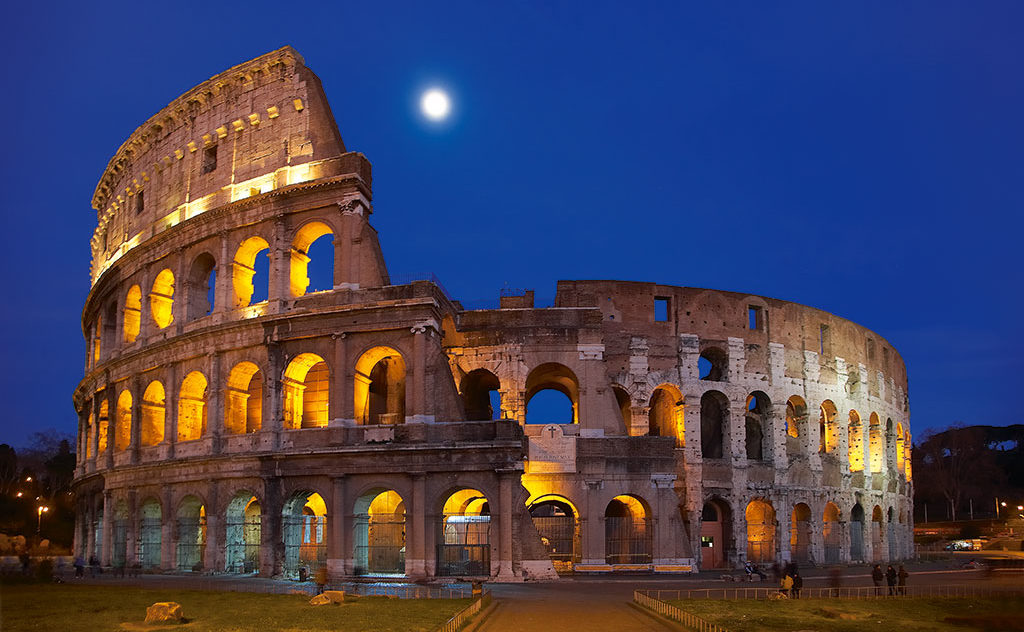
Colosseum was the largest amphitheater in the Roman world and is a remarkable example of ancient Roman engineering and architecture with the following approximate dimensions:
- Length: 189 meters (615 feet)
- Width: 156 meters (510 feet)
- Height: The original height is estimated to be around 48 meters (157 feet). However, due to the loss of the outer wall’s upper stories and other factors, its current height is approximately 38 meters (124 feet)
The Colosseum is not only a historical marvel but also a testament to the grandeur of ancient Rome. Its enduring legacy continues to captivate and inspire people from all around the world.
Here are some interesting facts about Colosseum:
- Iconic Amphitheater: The Colosseum, also known as the Flavian Amphitheatre, is an iconic symbol of ancient Rome. It is one of the most famous and well-preserved amphitheaters in the world.
- Construction Date: It was constructed between AD 70 and 80 under the Emperor Vespasian and his son Titus. The Emperor Domitian completed its construction in AD 81.
- Colossal Dimensions: The Colosseum is enormous, with a capacity to hold an estimated 50,000 to 80,000 spectators. It covers an area of about six acres.
- Gladiatorial Contests: The Colosseum was primarily used for gladiatorial contests, animal hunts, mock sea battles, and other public spectacles. These events often involved elaborate and dramatic sets.
- Ingenious Elevator System: Underneath the arena, there was a complex system of tunnels and cages that held gladiators and animals. Elevators and trapdoors allowed for dramatic entrances and exits.
- Diverse Entertainment: The Colosseum was not limited to combat events. It also hosted chariot races, theatrical performances, and other public gatherings.
- Materials Used: The Colosseum was built using concrete and sand, making it a marvel of Roman engineering. It is estimated that over 100,000 cubic meters of stone and concrete were used.
- Architectural Features: The Colosseum featured an awning system called the velarium, which could be extended to provide shade for the spectators. It also had a massive retractable roof.
- Destruction and Reuse: Over the centuries, the Colosseum suffered from earthquakes, fires, and stone-robbers. Much of its original marble cladding was removed and repurposed in other buildings.
- Restoration: In recent times, extensive restoration efforts have been made to preserve the Colosseum. Today, it is a UNESCO World Heritage Site and a popular tourist attraction.
- Symbol of Rome: The Colosseum is a symbol of Rome’s rich history and engineering prowess. It represents the grandeur of the Roman Empire and its contributions to architecture and entertainment.
- Night Illumination: The Colosseum is beautifully illuminated at night, offering a stunning sight for visitors and locals. It stands as a testament to Rome’s enduring legacy.
Circus Maximus: As you proceed, you’ll pass by Circus Maximus, where the ancient Romans cheered for their favorite charioteers. Today, it’s a vast public park with a track that once hosted thrilling chariot races.
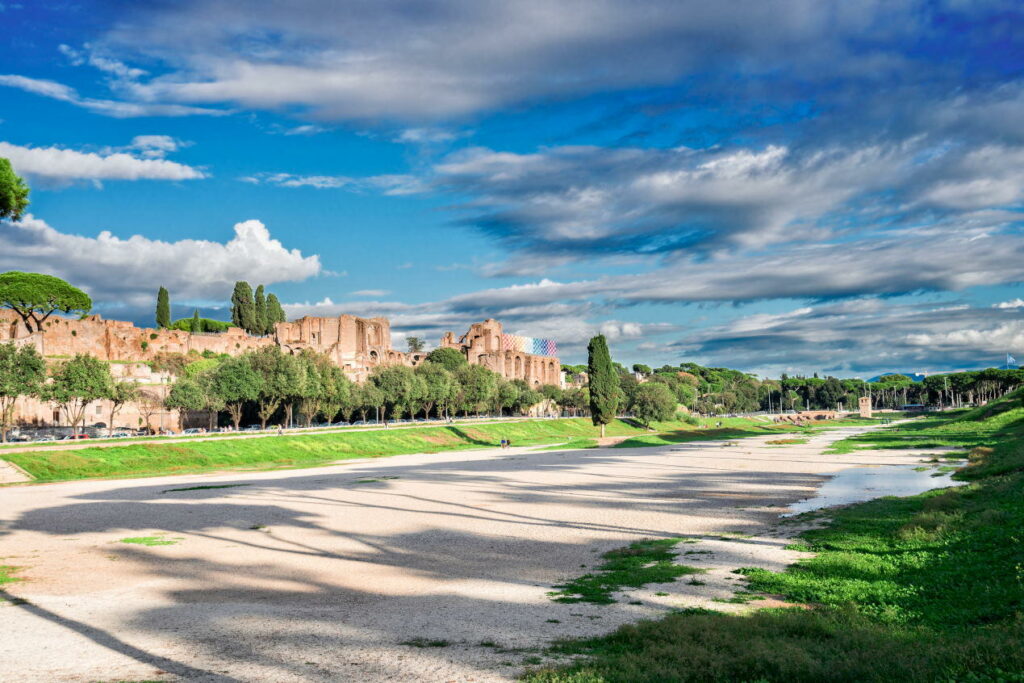
Visiting the Circus Maximus offers a fascinating glimpse into the grandeur of ancient Rome and the excitement of chariot racing, a sport that once captivated the hearts of Romans.
Here are some interesting facts about the Circus Maximus in Rome:
- Ancient Chariot Racing Stadium: The Circus Maximus, also known as “Circo Massimo” in Italian, was an ancient Roman chariot racing stadium. It is considered one of the most significant and largest entertainment venues in ancient Rome.
- Immense Size: The Circus Maximus could accommodate an astonishing number of spectators, with seating for over 150,000 people. This made it one of the largest sports arenas in ancient Rome.
- Location: Located in the valley between the Aventine and Palatine hills, the Circus Maximus provided a magnificent backdrop for chariot races.
- Architectural Features: The stadium featured a long, rectangular racetrack with a central barrier called the “spina.” This barrier was adorned with various statues and obelisks.
- Chariot Races: The primary purpose of the Circus Maximus was to host chariot races, which were among the most popular and thrilling events in ancient Rome. These races were a crucial part of Roman culture and often included intense rivalries.
- Reconstruction and Expansion: Over the centuries, the Circus Maximus went through multiple reconstructions and expansions. It underwent significant renovations during the reign of several emperors, including Julius Caesar and Augustus.
- Religious Celebrations: In addition to chariot races, the Circus Maximus was used for various religious celebrations, festivals, and ceremonies. It was a versatile venue for public events.
- Decline and Abandonment: With the fall of the Roman Empire, the Circus Maximus fell into disuse and disrepair. The structure’s materials were often scavenged for other construction projects, contributing to its gradual decline.
- Current State: Today, the Circus Maximus is an open public space in Rome. While the stadium itself is no longer intact, you can visit the archaeological remains of the site, which give you a sense of its grandeur during ancient times.
- Modern Use: In modern times, the Circus Maximus is occasionally used for public gatherings, concerts, and events. Its historical significance as a symbol of ancient Roman entertainment and culture continues to be celebrated
Aventino with the Keyhole: Aventino Hill awaits, known for the famous “Keyhole of Rome.” You’ll be enchanted by the perfectly framed view of St. Peter’s Basilica in Vatican City through this unique keyhole.Colosseum was the largest amphitheater in the Roman world and is a remarkable example of ancient Roman engineering and architecture
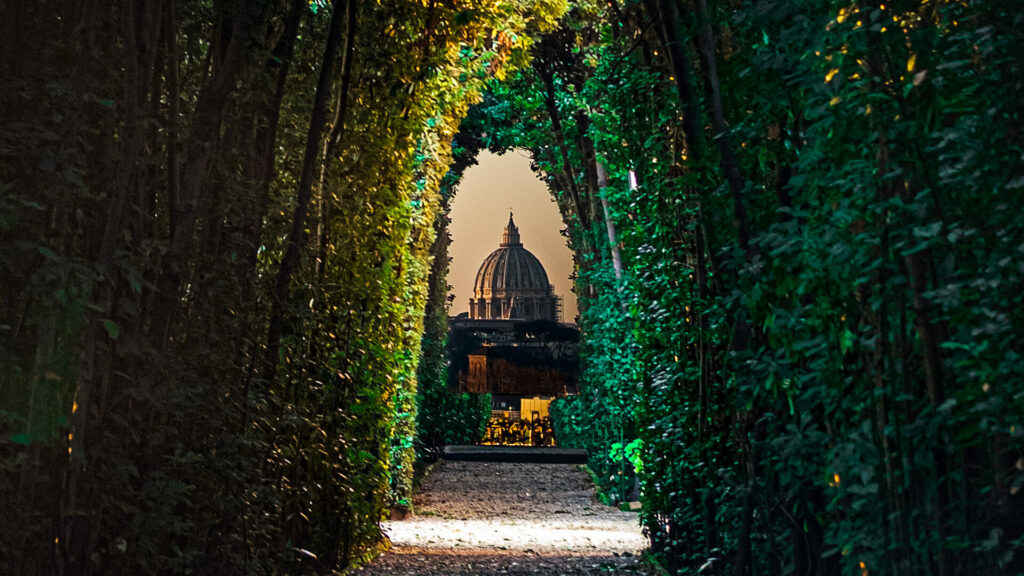
Visiting the Aventino Keyhole is a unique experience that offers not only a captivating perspective of St. Peter’s Basilica but also a sense of tranquility and wonder in the heart of Rome.
Here are some intriguing facts about the Aventino Keyhole in Rome:
- Unique Perspective: The Aventino Keyhole is a hidden gem in Rome, offering a truly unique and enchanting view of the city. This peephole is located within the door of the Priory of the Knights of Malta on the Aventine Hill.
- Location: Aventine Hill is one of Rome’s seven hills and is known for its picturesque and historic surroundings. The keyhole is situated in a quiet and green area, providing a stark contrast to the bustling city.
- Architectural Wonder: To experience this hidden wonder, visitors must look through the keyhole at the entrance to the Priory. The keyhole aligns perfectly with a pathway leading to the St. Peter’s Basilica dome, providing a stunning and perfectly framed view of the basilica.
- Triple Treat: The view through the Aventino Keyhole is a triple delight. When you peer through it, you’ll see three distinct layers: the keyhole’s border, the beautiful garden of the Priory, and the distant St. Peter’s Basilica. The effect is like looking at a beautifully composed painting.
- Symbolism: The keyhole offers more than just a fantastic view; it carries symbolic significance. It’s often said that looking through the keyhole symbolizes the act of peering into another world or a spiritual revelation, with the sight of St. Peter’s Basilica serving as a spiritual destination.
- Access: The Aventino Keyhole is open to the public, and you can visit it without an entrance fee. However, the best time to visit is during daylight hours when the keyhole and the garden are accessible.
- St. Peter’s Basilica: The view of St. Peter’s Basilica is particularly captivating in the evening when the dome is beautifully illuminated. It’s a popular spot for both tourists and locals to enjoy a serene moment of contemplation.
- Quiet Oasis: The surrounding area is a peaceful and lush garden, making it a tranquil oasis amid the bustling city. It’s a perfect place to relax and enjoy the stunning view.
St. Peter’s Basilica: Next, you’ll visit the awe-inspiring St. Peter’s Basilica, a Renaissance masterpiece and the heart of Catholicism. The splendid architecture and religious art within the basilica are a sight to behold.
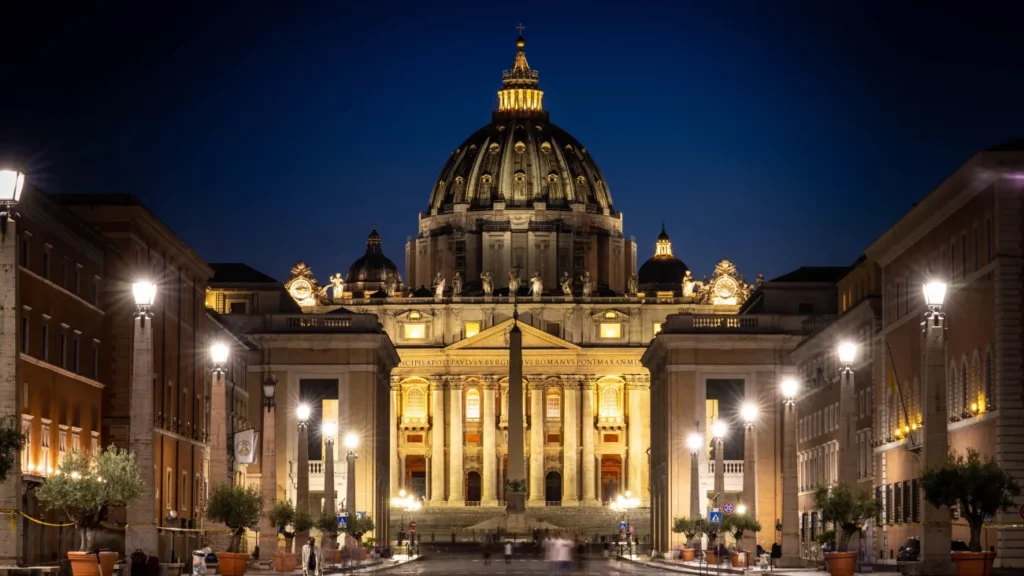
St. Peter’s Basilica stands as a testament to both architectural and religious achievement, drawing visitors from around the world to admire its grandeur and significance.
The colonnades of St. Peter’s Basilica, designed by the renowned Baroque sculptor and architect Gian Lorenzo Bernini, are a remarkable architectural feature that adds to the grandeur of the basilica and St. Peter’s Square. Here’s more on these impressive columns:
Design and Layout:
- The colonnades consist of four rows of columns, each row with 44 columns, for a total of 176 columns on each side. This design creates the effect of two massive arms reaching out to embrace visitors as they enter St. Peter’s Square.
Symbolic Embrace:
- Bernini’s design is often described as a symbolic gesture of the Catholic Church, welcoming and embracing the faithful and pilgrims. The colonnades create a sense of inclusion and unity as people gather in the square.
Doric Columns:
- The columns are of the Doric order, characterized by their simplicity and the absence of a decorative capital. They are made of travertine stone, a commonly used building material in Rome.
Optical Illusion:
- Bernini skillfully designed the columns with a slight curvature so that, when viewed from the center of the square, they appear perfectly straight. This optical illusion enhances the visual impact of the colonnades.
Obelisk and Fountains:
- In the center of St. Peter’s Square stands an ancient Egyptian obelisk, flanked by two stunning fountains also designed by Bernini. The obelisk and fountains complement the grandeur of the colonnades.
Papal Blessings:
- The colonnades are not just a work of art but also have a practical purpose. During papal blessings and ceremonies, the Pope can stand on the balcony above the central entrance and impart his blessings to the crowd gathered in the square below.
The colonnades of St. Peter’s Basilica are a testament to Bernini’s architectural genius and continue to be a symbol of welcome, unity, and spirituality for millions of visitors and worshippers who come to Vatican City.
Here are some interesting facts and a brief history of St. Peter’s Basilica:
- Size and Scale: St. Peter’s Basilica is one of the largest churches in the world, with a length of 220 meters (720 feet) and a dome that reaches a height of 136.57 meters (448.1 feet). The basilica can accommodate around 15,000 people.
- Artistic Masterpieces: The basilica is a treasure trove of art, including works by famous artists like Michelangelo, Raphael, and Gian Lorenzo Bernini. Michelangelo’s masterpiece, the “Pieta,” is on display here.
- Dome of St. Peter’s: The dome of St. Peter’s Basilica was designed by Michelangelo and is a stunning architectural feat. Visitors can climb to the top for a panoramic view of Rome.
- Basilica Layout: St. Peter’s is built in the shape of a Latin cross, with a central nave and four aisles. The basilica’s main altar is positioned directly above the tomb of St. Peter.
- St. Peter’s Square: The basilica is surrounded by St. Peter’s Square, an expansive piazza designed by Gian Lorenzo Bernini. It can accommodate up to 80,000 people, making it a significant location for papal gatherings and events.
- St. Peter’s Obelisk: In the center of St. Peter’s Square stands an ancient Egyptian obelisk that was brought to Rome in 37 AD. It is one of the city’s most well-preserved ancient obelisks.
History:
- Construction Begins: St. Peter’s Basilica was built on the site where St. Peter, one of Jesus’s twelve apostles and the first Pope, was believed to be buried. Construction of the basilica began in 1506 during the Renaissance era.
- Multiple Architects: The construction of the basilica involved several architects, including Bramante, Raphael, and Antonio da Sangallo. However, it was Michelangelo who had a significant influence on the final design.
- Dome Completion: After Michelangelo’s death, the dome was completed by Giacomo Della Porta and Domenico Fontana. The dome is now one of the most recognizable features of the basilica.
- Papal Basilica: St. Peter’s is one of the four major papal basilicas in Rome, and it is considered the most important of all. It serves as a significant religious and pilgrimage site for Catholics worldwide.
- Renovations and Additions: Over the centuries, the basilica has undergone renovations and additions. Gian Lorenzo Bernini was responsible for designing the impressive St. Peter’s Square and the colonnades that frame it.
- Holiness and Tradition: St. Peter’s Basilica is a symbol of the Catholic Church and the seat of the Pope. It is a place of pilgrimage for Catholics and hosts various religious ceremonies and traditions, including the Papal Mass on Easter Sunday.
- Historic Papal Events: St. Peter’s Basilica has been the site of numerous historic events, such as papal coronations and beatifications, as well as the selection of new Popes in papal conclaves
Gianicolo: Gianicolo Hill offers a serene and panoramic view of Rome at night. It’s a perfect spot to relax and soak in the city’s lights and history.
Piazza Navona: Your journey takes you to Piazza Navona, a lively public square graced with three stunning fountains, including the famous Fontana dei Quattro Fiumi by Gian Lorenzo Bernini. The square is alive with cafes, restaurants, and street performers.
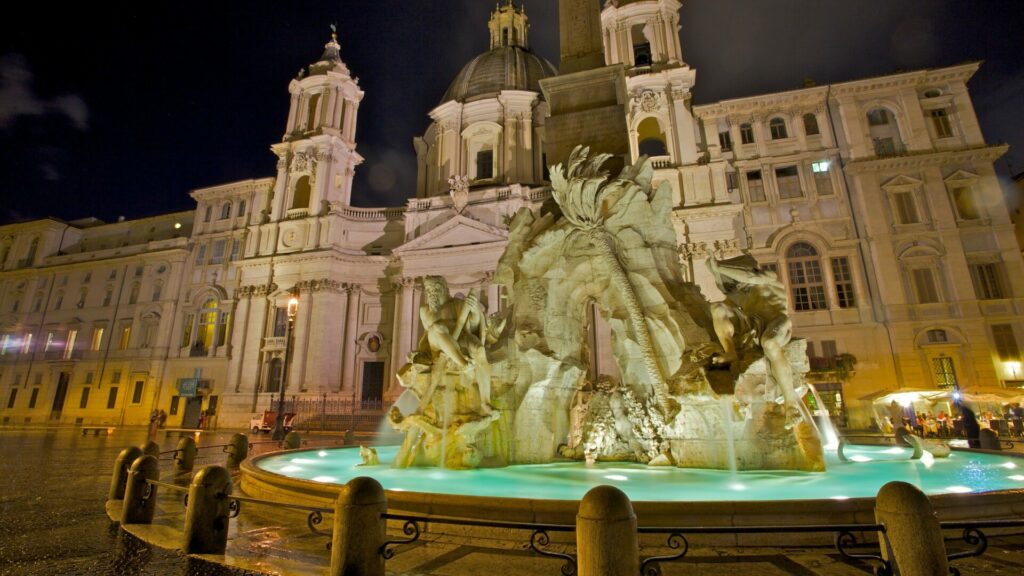
Piazza Navona’s harmonious blend of history, art, and vibrant street life makes it one of the most enchanting squares in Rome.
here are some interesting facts about Piazza Navona:
- Baroque Masterpiece: Piazza Navona is one of Rome’s most famous squares and a masterpiece of Baroque architecture. It’s known for its stunning fountains, palaces, and vibrant atmosphere.
- Stadium of Domitian: The square sits on the site of the Stadium of Domitian, which was used for ancient Roman athletic contests, primarily in the 1st century AD. The stadium could accommodate up to 30,000 spectators.
- Bernini’s Fountains: Piazza Navona is home to three exquisite fountains. The most famous is the Fontana dei Quattro Fiumi (Fountain of the Four Rivers) designed by Gian Lorenzo Bernini. It represents the four major rivers from four continents: the Nile, Ganges, Danube, and Rio de la Plata.
- Baroque Churches: The square is surrounded by several Baroque churches, the most notable being Sant’Agnese in Agone. Its dome is said to be an architectural response to the nearby St. Peter’s Basilica.
- The Annual Christmas Market: Piazza Navona hosts a lively Christmas market every year. The square is transformed into a festive wonderland with stalls selling holiday decorations, nativity scenes, and seasonal treats.
- Street Performers: Piazza Navona is often bustling with street performers, artists, and musicians. It’s a great place to enjoy live entertainment while taking in the historic surroundings.
- Food and Cafes: The square is lined with charming cafes and restaurants, making it a fantastic place to savor Italian cuisine while people-watching.
- Influential History: Piazza Navona has been a hub of Roman life for centuries. In the past, it was a market, a horse race track, and a place for various public gatherings.
- Obelisk of Domitian: At the center of the square stands an ancient Egyptian obelisk, the Obelisco Agonale. It was originally brought to Rome in the 1st century AD and placed in the stadium. Pope Innocent X had it moved to the center of Piazza Navona in the 17th century.
- Tourist Attraction: Piazza Navona is a must-visit for tourists. It captures the essence of Rome’s rich history, art, and culture, making it a popular destination for sightseeing and relaxation.
The Fontana dei Quattro Fiumi, or the Fountain of the Four Rivers, located in Piazza Navona, is one of the most famous and iconic works of Baroque art. Here are more details about this magnificent fountain:
Designer:
- The Fountain of the Four Rivers was designed by the renowned Baroque sculptor and architect Gian Lorenzo Bernini. It was commissioned by Pope Innocent X in 1648 as part of the embellishment of Piazza Navona.
The Four Rivers:
- The fountain represents four major rivers from different continents, each personified by a massive marble statue. The rivers are the Nile (representing Africa), the Ganges (representing Asia), the Danube (representing Europe), and the Río de la Plata (representing the Americas).
River Personifications:
- Each river statue is depicted with unique attributes. For instance, the Nile figure has a veiled head, symbolizing the river’s unknown source. The Ganges is depicted with an oar, symbolizing the river’s navigability. The Danube is shown with the Pope’s coat of arms, reflecting the Vatican’s control over the regions through which the Danube flows. The Río de la Plata has a pile of coins, representing the riches of the Americas.
- The Fountain of the Four Rivers in Piazza Navona, designed by Gian Lorenzo Bernini, features various animals as part of its intricate and symbolic composition. Each of these animals is carefully incorporated into the fountain’s design to convey layers of meaning and artistry:
- Horse (in the Ganges Figure): The figure representing the Ganges River features a rearing horse. This horse is a symbol of the Ganges’s navigability, emphasizing the river’s importance as a transportation route.
- Crocodile (at the Nile Figure’s Feet): At the feet of the statue representing the Nile, there is a crouching crocodile. This detail symbolizes the river’s mysterious and uncharted origins, as the source of the Nile was unknown to Europeans for a long time.
- Lion (in the Danube Figure): The Danube River statue is accompanied by a fierce-looking lion. The lion holds the papal coat of arms. This emblem signifies the papal authority and control over the regions through which the Danube flows.
- Dolphin (in the Río de la Plata Figure): The statue representing the Río de la Plata features a playful dolphin at its base. The dolphin represents the rich marine life in the Americas and adds to the overall vibrancy of the fountain.
- These animals are not just decorative elements but are carefully selected to enhance the symbolic representation of the four major rivers from different continents. They contribute to the dynamic and dramatic composition of the fountain, adding to the overall visual impact of this Baroque masterpiece.
Dramatic Composition:
- The composition of the fountain is dynamic and dramatic. The statues appear to be in motion, and their bodies are intertwined with animals, plants, and rocks, creating a sense of chaotic energy.
Obelisk and Dove:
- Rising from the center of the fountain is an ancient Egyptian obelisk, the Obelisco Agonale, which was moved to its current location by Pope Innocent X. At the top of the obelisk, a dove stands as a symbol of peace.
Political and Religious Symbolism:
- The Fountain of the Four Rivers carries both political and religious symbolism. At the time of its creation, it was seen as a celebration of the powerful Roman Catholic Church and the pope’s control over the world’s continents.
Inspiration for Competing Artists:
- Bernini’s masterpiece in Piazza Navona set a high standard for Baroque art in Rome and inspired other artists of the time to create remarkable sculptures and fountains in the city.
Restoration:
- The fountain has undergone several restorations to maintain its grandeur and preserve its artistic details.
The Fountain of the Four Rivers, designed by Gian Lorenzo Bernini, remains a testament to the brilliance of Baroque art and is a must-see attraction for art and history enthusiasts visiting Rome. It continues to captivate visitors with its intricate details, dynamic composition, and symbolism.
Pantheon: The Pantheon, with its iconic dome and open oculus, is your next destination. Explore its grand interior and admire its architectural brilliance.
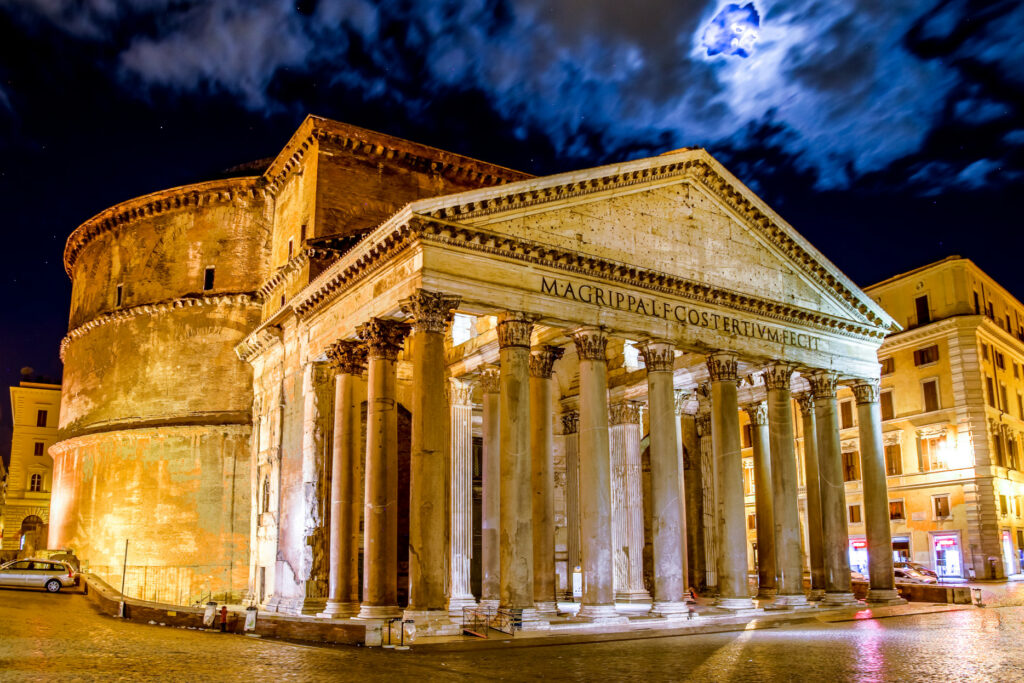
Piazza della Rotonda, with its historical charm and proximity to the iconic Pantheon, is a must-visit destination for anyone exploring Rome’s historic center.
Here are some intriguing facts about Piazza della Rotonda, commonly known as the square in front of the Pantheon:
- Historical Significance: Piazza della Rotonda is one of the most iconic and historically significant squares in Rome, primarily due to its proximity to the Pantheon.
- Location: The square is located in the historic center of Rome, just in front of the Pantheon, one of the best-preserved ancient Roman buildings.
- Pantheon: The main attraction of the square is, of course, the Pantheon. This ancient temple-turned-church is known for its stunning dome and is a remarkable example of Roman engineering and architecture.
- Obelisk: In the center of the square, you’ll find an ancient Egyptian obelisk known as the Obelisco Agonale or Piazza della Rotonda Obelisk. It was brought to Rome from Egypt and placed here in the 18th century.
- Surrounding Buildings: Piazza della Rotonda is surrounded by several historic buildings, many of which house cafes and restaurants. It’s a lovely spot for enjoying a meal or a coffee while admiring the Pantheon.
- Street Performers: The square is often filled with street performers, artists, and musicians, adding to the lively atmosphere and creating a vibrant cultural scene.
- Fountain: A small but elegant fountain, the Fontana del Pantheon, is located on one side of the square. It’s a popular spot for tourists to take photos and cool off in the Roman heat.
- Piazza Navona Proximity: Piazza della Rotonda is just a short walk away from the famous Piazza Navona, another one of Rome’s beautiful squares. These two squares are often visited together.
- Diverse Visitors: Piazza della Rotonda is a popular gathering place for both locals and tourists. It’s a great spot for people-watching and enjoying the architectural wonders of the Pantheon.
- Nighttime Magic: The square takes on a magical ambiance at night when the Pantheon is beautifully illuminated. Visitors often choose to explore the Pantheon and the square in the evening when the daytime crowds have subsided.
Pantheon Historical Facts:
- Ancient Origins: The Pantheon is one of Rome’s most iconic and well-preserved ancient monuments. It was originally built as a temple during the reign of Emperor Augustus (27 BC – 14 AD). The current structure is believed to be the third version of the Pantheon, with the previous two being destroyed by fire.
- Dedication: The Pantheon was dedicated to all the gods (the name “Pantheon” is derived from the Greek words “pan,” meaning “all,” and “theos,” meaning “god”). It was intended as a place of worship for various deities.
- Conversion to a Church: In the 7th century, the Pantheon was converted into a Christian church, which played a crucial role in its preservation. This transformation saved it from the destruction that befell many other ancient Roman temples.
- Renaissance Influence: The Pantheon had a significant impact on Renaissance architecture. Its iconic dome, in particular, influenced many famous architects, including Michelangelo and Brunelleschi.
Pantheon Architectural Facts:
- Dome Design: The most famous feature of the Pantheon is its massive dome, which was an engineering marvel in its time. The dome is constructed of unreinforced concrete, and it’s still considered the world’s largest unreinforced concrete dome.
- Oculus: At the center of the dome is the oculus, a circular opening that provides natural light and ventilation to the interior. It also represents the connection between the temple and the divine.
- Dome Thickness: The thickness of the dome’s walls decreases as it ascends, which helps to distribute the weight evenly and reduce stress. The dome’s design was ahead of its time in terms of structural engineering.
- Materials: The exterior of the Pantheon is faced with columns and a pediment made of Egyptian granite, while the interior is filled with various types of colored marble and stone. The use of these materials gives the building a striking visual effect.
- Dome’s Height and Diameter: The height of the Pantheon’s dome is equal to its diameter, measuring approximately 43.3 meters (142 feet). This proportion is considered an architectural masterpiece and was widely imitated in subsequent architectural designs.
- Perfect Spherical Interior: The interior of the dome is a perfect hemisphere, providing a sense of balance and harmony. It is considered a remarkable achievement in architectural design.
- Preservation: The Pantheon’s remarkable state of preservation can be attributed to its continuous use as a place of worship and the fact that it was never abandoned or significantly altered over the centuries.
- Tourist Attraction: Today, the Pantheon is a popular tourist attraction and still serves as a church, known as the Basilica of Santa Maria ad Martyres. Visitors can explore its stunning interior and appreciate the architecture, history, and art it houses.
Fontana di Trevi: Your night tour wouldn’t be complete without a visit to the Fontana di Trevi, one of the world’s most famous fountains. Don’t forget to make a wish and toss a coin into the fountain, following the tradition depicted in the film “Three Coins in the Fountain.”
The Trevi Fountain is not just a remarkable piece of art; it’s a symbol of hope, love, and the eternal charm of Rome, making it a must-visit attraction for travelers from around the world.
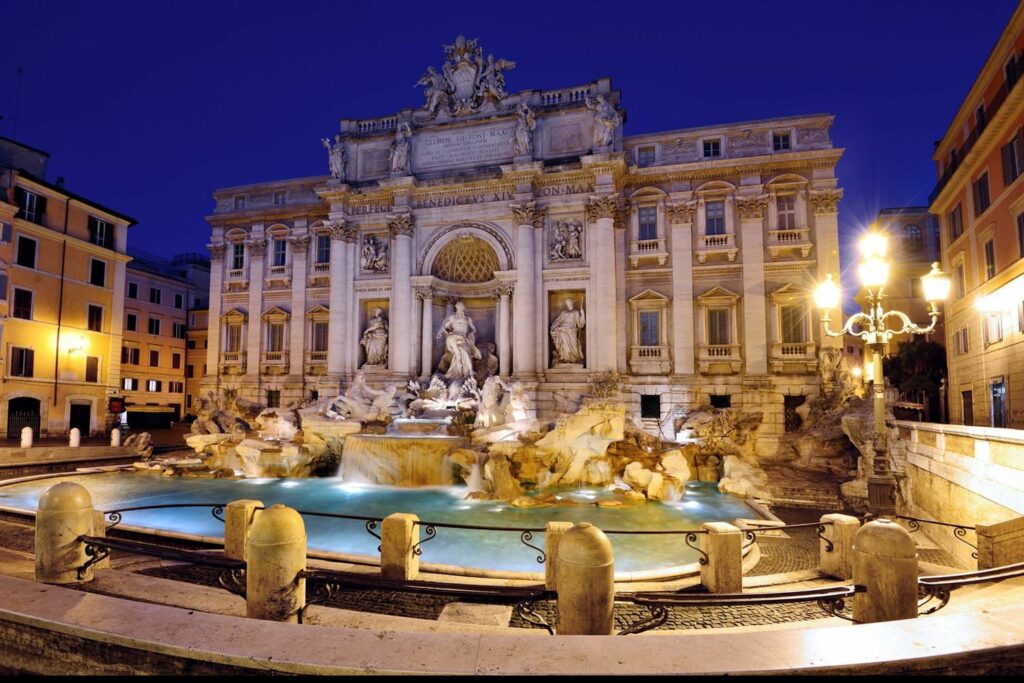
Here are some fascinating facts about the Trevi Fountain in Rome:
- Baroque Masterpiece: The Trevi Fountain, known as “Fontana di Trevi” in Italian, is one of the most renowned Baroque-style fountains in the world. It stands as a masterpiece of this artistic and architectural period.
- Historical Origins: The fountain’s history dates back to ancient Roman times when there was a spring at the junction of three roads, “tre vie” in Italian, giving the fountain its name.
- Nicola Salvi: The current fountain is the result of a design by Italian architect Nicola Salvi in the 18th century. Work on the fountain began in 1732, and it was completed in 1762.
- Mythical Statues: The central focus of the Trevi Fountain is the statue of Neptune, the Roman god of the sea, riding a chariot in the shape of a shell. He is accompanied by two Tritons, one trying to control a wild sea horse and the other a calm one. The statues represent the contrasting moods of the sea.
- Marble and Stone: The fountain is a splendid work of art, crafted from a combination of white Carrara marble, travertine stone, and various other high-quality materials. Its rich and intricate detail reflects the skill of the artisans who contributed to its creation.
- Iconic Scene: The Trevi Fountain is famous for the iconic scene in Federico Fellini’s film “La Dolce Vita” where actress Anita Ekberg wades into the fountain’s waters. This moment has become an enduring symbol of Rome and its allure.
- Coin Tradition: Throwing a coin over your left shoulder into the Trevi Fountain is a beloved tradition. According to legend, one coin ensures your return to Rome, two coins will lead to a new romance, and three coins will lead to a wedding or divorce. The coins are collected and donated to charity.
- Restoration: The fountain underwent a major renovation in the 1990s, which was sponsored by the Italian fashion company Fendi. This extensive restoration ensured the preservation of the fountain’s stunning features.
- Water Source: The Trevi Fountain is not just a work of art but also a functional fountain. It is supplied with water from the Acqua Vergine, an ancient Roman aqueduct that has been providing fresh water to Rome for centuries.
- Daily Illumination: The Trevi Fountain is beautifully illuminated at night, adding to its magical atmosphere. This illumination allows visitors to appreciate its beauty both during the day and in the evening.
Spanish Steps: Finally, your tour concludes at the Spanish Steps (Piazza di Spagna), a monumental stairway with 135 steps. These steps lead to the Trinità dei Monti church and are known for their unique design and the Fontana della Barcaccia, a beautiful boat-shaped fountain at their base.
Visiting the Spanish Steps and the Barcaccia Fountain is a delightful experience, offering a combination of architectural beauty, historical significance, and a charming Roman ambiance.
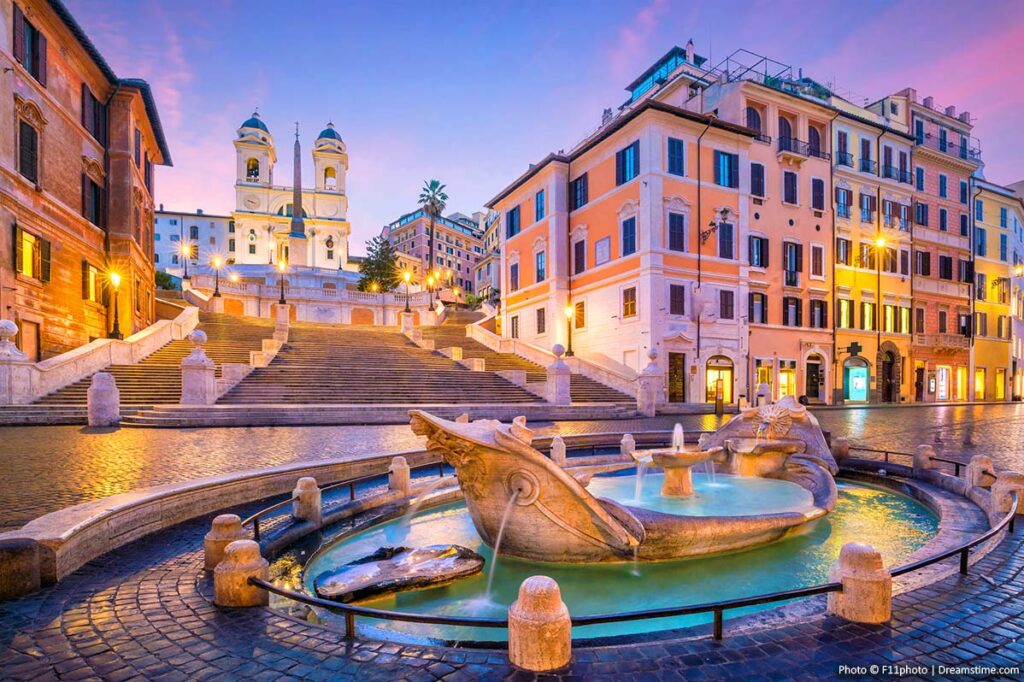
Here are some interesting facts about the Spanish Steps and the Barcaccia Fountain:
Spanish Steps:
- Architectural Marvel: The Spanish Steps, known as “Scalinata di Spagna” in Italian, are a monumental stairway of 135 steps. They are one of the most famous sets of steps in the world and a masterpiece of Baroque architecture.
- Trinità dei Monti: The Spanish Steps lead to the Trinità dei Monti church at the top. The design of the steps and the church creates a stunning visual effect, especially when viewed from the base of the steps.
- Keats and Shelley: The Keats-Shelley House, located to the right of the steps, was the final dwelling place of the Romantic poets John Keats and Percy Bysshe Shelley. It’s now a museum dedicated to their works and lives.
- Piazza di Spagna: At the base of the steps is Piazza di Spagna, a lively and charming square. It’s a popular gathering place and a hub for fashion enthusiasts, as many high-end boutiques and designer stores are located nearby.
- Annual Events: The Spanish Steps serve as the backdrop for various events and celebrations, including the famous Christmas nativity scene. The steps are adorned with a stunning Christmas tree and are a focal point of Rome’s holiday festivities.
Barcaccia Fountain:
- Boat-Shaped Fountain: The Fontana della Barcaccia, or Barcaccia Fountain, is a unique boat-shaped fountain located at the base of the Spanish Steps. It was designed by Pietro Bernini and his son Gian Lorenzo Bernini, who is famous for his contributions to Baroque art.
- Sculpted Sun: The centerpiece of the Barcaccia Fountain is a sculpted sun with the papal symbol, the family crest of Pope Urban VIII, whose family commissioned the fountain. The design is a reminder of the pope’s family name, Barberini, which means “little boat.”
- Flooding Inspiration: The design of the Barcaccia Fountain is believed to have been inspired by a historical event. In 1598, the Tiber River flooded, leaving a small boat stranded at this spot. The fountain’s design commemorates this event.
- Bee Symbolism: The Barberini family’s coat of arms features three bees, and you can find this symbol on the fountain. Bees represent industriousness and are linked to the family’s rise in power and prestige.
Your private limo and guide will ensure that you have an unforgettable and personalized experience exploring Rome’s illuminated wonders at night. Enjoy this magical journey through the Eternal City!

